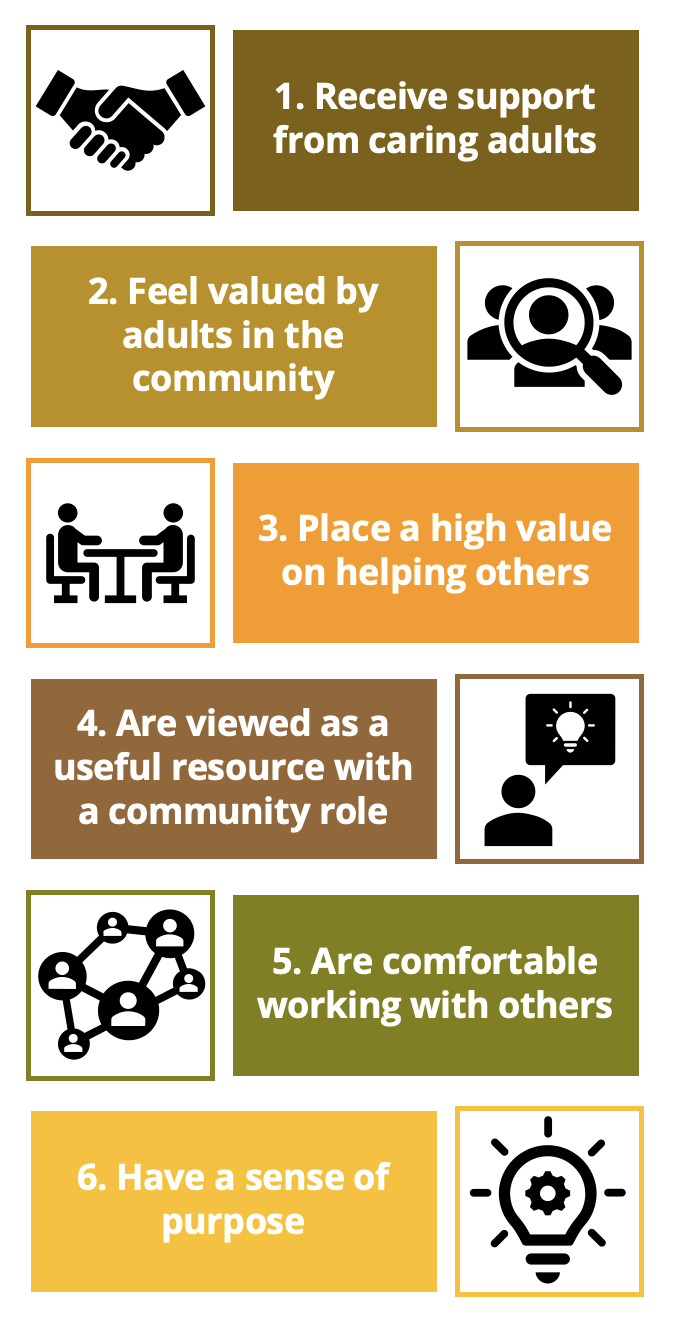The 6 C’s of Positive Youth Development: Praise Today, Contribute Tomorrow
With Angie’s support, Jasmine graduated from high school, saved money for an apartment, and got a manager position in a retail store. Jasmine even created a high school internship program to help students gain experience in leadership and management positions. She called it “The Angie Training Program,” in honor of her inspiring role model and dear friend. She couldn’t wait to tell Angie.
If you identify with Angie, this publication is for you! It’s the sixth and final installment of the Positive Youth Development (PYD) Series, and it focuses on motivating youth to contribute.
Mississippi 4-H is a youth organization made up of Extension Agents, volunteers, and caring adults who utilize the 6 C’s of Positive Youth Development to help young people develop the competencies for life-long success. While this publication is intended for adults working with young people in the 4-H youth development program, it applies to adults who work with youth across a variety of programs.
______________________________________________________________________________________________________________
The desire to give back is something that comes naturally to many people, and for PYD program adults, it’s one of the factors that drives their work. However, even the most determined PYD adults have difficulties motivating young people to contribute, but this doesn’t stop them. If anything, it encourages PYD adults to go the extra mile.
Praise leads to contributions
As a PYD program adult, you are in charge of creating a comfortable, safe, and supportive environment for youth to develop. A key part of this is establishing and maintaining positive and trusting relationships with them. You must keep in mind that anything that you do or say can be powerful enough to help youth envision their future selves. You have a vital role in who they become. Something that youth appreciate and that encourages them is praise, but only when appropriate. You can praise them in three ways:

For example, 4-H youth programs offer numerous recognition opportunities for youth behavior and work. It’s important to praise young people with respect and admiration, but not in a child-like manner. This makes young people feel competent and worthy—fueling their spark to continue working toward the best version of themselves.
Contributions go both ways
Youth need three critical elements to make meaningful contributions:
- critical reflection,
- hopeful future expectations, and
- mentoring relationships.
Active youth engagement reflects how they contribute to themselves, family, friends, community, and society. As youth participate and engage in more activities, they will contribute more.

(Adapted from Bowers et al., 2021)

Youth are motivated to contribute when they:
Individual contributions are linked to community contributions— what you contribute to one person can have an impact on others. Leadership and service are important values that feed the motivation needed to contribute to the surrounding community.
At its core, being motivated to contribute is the belief that you can make a difference in the world followed by action. Contributions are much more powerful when they are directly related to a specific goal. If you notice that your PYD program participants want to achieve something in particular, that’s a great opportunity for them to contribute to a cause, whether that’s improving their family’s relationships, finishing high school, rescuing animals, or serving food to the homeless.
Acts of contribution can occur anywhere—school, church, home, at the park, and even in convenience stores. 4-H offers youth volunteering opportunities that can foster their sense of community and purpose. This can improve their well-being, success rate, and community involvement.
Youth contribution can lead to positive community action, which is why your contributions as a PYD adult are indirect contributions to your community. Encouraging youth to help their neighbors, volunteer, mentor children, lead protests, and bring their families together are examples of youth contributions. It’s giving them the opportunity and power to rise to action.
If you would like to know what youth have gained through participation in a program, you can use the Positive Youth Development Instrument to find out. It’s a series of questions that you can ask before the program starts and again after it ends to evaluate what participants learned. You can use the following table as a guide.
Character Evaluation for PYD Program Participants
|
Tell us how strongly you agree or disagree with |
Strongly disagree |
Disagree |
Neither agree nor disagree |
Agree |
Strongly agree |
|---|---|---|---|---|---|
|
I take an active role in my community. |
|||||
|
I am someone who gives to benefit others. |
|||||
|
I like to work with others to solve problems. |
|||||
|
I have things I can offer to others. |
|||||
|
I believe I can make a difference in the world. |
|||||
|
I care about contributing to make the world a better place for everyone. |
|||||
|
It’s important for me to try and make a difference in the world. |
Adapted from Arnold et al., 2012
Summary
When youth recognize their competence, confidence, and character, and they connect and care for others, they are ready to contribute and give back what they have received. Praising young people is a great start, and you can do this through behavior-specific encouragement, positive reinforcement, and recognition.
Remember, contribution stands on three pillars: hopeful future expectations, mentoring relationships, and critical reflection. To motivate youth to contribute, make sure that they receive support from caring adults, feel valued, place a high value on helping others, are seen as useful resources, are comfortable working with others, and have a sense of purpose. When youth contribute, positive youth development efforts reach their full-circle moment.
Reach out to your local 4-H office for opportunities, guidance, and support as you navigate the 6 C’s of PYD!
References
Alberts, A. E., DiDenti, E., Chase, P., Naudeau, S., Phelps, E., & Lerner, R. 2006. Qualitative and Quantitative Assessments of Thriving and Contribution in Early Adolescence: Findings from the 4-H Study of Positive Youth Development. Journal of Youth Development, 1 (2), 0602FA002.
Bowers, E. P., Bolding, C. W., Rapa, L. J., & Sandoval, A. M. 2021. Predicting Contribution in High Achieving Black and Latinx Youth: The Role of Critical Reflection, Hope and Mentoring. Frontiers in Psychology, 12, 681574.
Jelicic, H., Bobek, D. L., Phelps, E., Lerner, R. M., & Lerner, J. V. 2007. Using Positive Youth Development to Predict Contribution and Risk Behaviors in Early Adolescence: Findings from the First Two Waves of the 4-H Study of Positive Youth Development. International Journal of Behavioral Development, 31 (3), 263-273.
Moran, S. 2020. Life Purpose in Youth: Turning Potential Into a Lifelong Pursuit of Prosocial Contribution. Journal for the Education of the Gifted, 43 (1), 38-60.
Wallace, R. E. 2021. The Theoretical Influence of Praise Given to Teen Leaders at 4-H Camp on Their Feelings of Contribution and Motivation. Journal of Human Sciences and Extension, 9 (2), 12.
Zarrett, N. & Lerner, R. M. (2008). Ways to Promote the Positive Development of Children and Youth. Child Trends Research to Results Briefs.
___________________________________________________________________________________
Publication 3947 (POD-11-23)
By Patricia Marie Cordero-Irizarry, Doctoral Student, Agricultural and Extension Education; Mariah Smith Morgan, PhD, Associate Extension Professor, Center for 4-H Youth Development; and Donna J. Peterson, PhD, Extension Professor, Human Sciences.
The Mississippi State University Extension Service is working to ensure all web content is accessible to all users. If you need assistance accessing any of our content, please email the webteam or call 662-325-2262.



